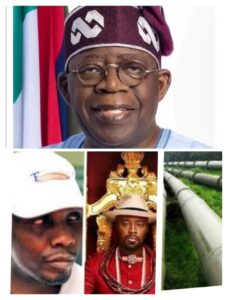THE NEED FOR THE PRESIDENT BUHARI-LED FEDERAL GOVERNMENT TO BREAK THE YOKE OF THE GAS FLARE POLITICS IN NIGERIA WITH ITS NIGERIAN GAS FLARE COMMERCIALIZATION PROGRAMME (NGFCP)
With recent reports that the ongoing Nigerian Gas Flare Commercialization Programme (NGFCP) of the Federal Government will attract $3.5bn worth of investments to Nigeria, and that the burden of gas flare will eventually be addressed in few years to come, we are glad to say that finally, Nigerians are witnessing something different from the usual gas development and gas-flare-end politics played by past Governments. All that we are urging the President Muhammadu Buhari-led administration, is that its NGFCP initiative should not end up on paper or in the book shelves like we have witnessed with past administrations. But rather, President Buhari, as the sitting President, as well as the Honourable Minister of State for Petroleum Resources, Dr. Ibe Kachikwu, should ensure that its ongoing Gas Flare Commercialization, which will liberalize the development of the nation’s gas sector, actually becomes a ‘reality’. As such, the Federal Government should ensure that not even its agencies like the Department of Petroleum Resources (DPR), should stand as a bottleneck to the prompt realization of this objective as intended by the Federal Ministry of Petroleum Resources. The Federal Government should invest on this neglected aspect of the nation’s gas sector with all that required to make a reality. It is about time this yoke and spell of gas flare politics, which has become a song by past Federal administrations since 1999, is broken once and for all.
According to the recent online report by Punch Nigeria as published on February 20, 2019, Senior officials of the Federal Ministry of Petroleum Resources, specifically the Program Manager, NGFCP, Mr. Justice Derefaka, he explained that “inward investments valued at about $3.5bn are coming into the country to achieve the gas flare commercialization targets by 2020.” He added, “The benefits are huge, ranging from an overall investment of around $3bn to $3.5bn; a potential annual revenue and Gross Domestic Product impact of around $1bn.”
The report also noted that the gas commercialization programme would create about 300,000 direct and indirect jobs and reduce Nigeria’s Carbon IV Oxide emission by 13 million tons annually. According to the said online report, Derefaka added: “And assuming an average project size ranging from $10m to $40m, the NGFCP has a potential of triggering 70 to 89 projects. And over a 1.5 and two-year period, the NGFCP could generate approximately 300,000 direct and indirect jobs. And once operational, projects launched under the NCFCP would reduce Nigeria’s emissions by 13 million tonnes of CO2 per year. And don’t forget, the NGFCP can become an important source of additional gas for the power sector.”
This is no doubt, a lofty objective that would change the narrative in the nation’s gas sector in the interest of the Nigerian economy and the Nigerian people, especially those in the Niger Delta region who have been bearing and enduring the brunt of the gas flare situation in the region.
The report also noted that over 700 interested organizations/companies had already registered on the Nigerian Gas Flare Commercialization Programme portal to jostle for about 178 gas flare sites located in the Niger Delta region. It stated that more organizations/companies were still bidding for gas flare sites in the Niger Delta, as the submission date for the NGFCP Registration and Submission of Statement of Qualification (SOQ) for the Request for Qualification (RfQ), had been extended to February 28, 2019. According to a recent statement obtained from the secretariat of the NGFCP in Abuja, the programme has continued to gain immense attraction. The statement further revealed that: “After the close of the submission of the SOQs’, there will be an opening ceremony for the SOQs’ after which the Proposals Evaluation Committee (PEC) duly constituted by the Minister of State For Petroleum Resources, for the purpose of evaluating the SOQs presented by the applicants to determine qualified applicant status and evaluating the proposals to determine those applicants – whether they have been awarded the Qualified Applicant (QA) status.” Stating how the submitted bid would be evaluated, the statement noted that: “A list of the selected qualified applicants will be published on the NGFCP Portal. Only QAs will be issued the Request for Proposal (RfP) package. The PEC will carry out an evaluation of the technical and commercial proposal on a strictly pass/fail basis. The financial proposals will be opened only for those bidders whose technical and commercial proposals have passed.”
Also, the recent appointment of the new Chairman of the Ministerial Steering Committee (SteerCo) of the Nigerian Gas Flare Commercialization Programme, Engr. Rabiu Suleiman, who is a Senior Technical Adviser, Refineries, Gas, Power and Downstream Infrastructure to the Minister of State for Petroleum Resources, Dr. Ibe Kachikwu, has shown the seriousness of the Federal Government in driving the gas flare commercialization programme with the deserved attention. As we often noted in times past, before now, the country loses a lot of fortunes from endless gas flaring even in face of mounting anger of both local residents of the Niger Delta region and even the economy that is importing the same product it is flaring. Suleiman is said to be coming from a deep-rooted wealth of professional experience in the Oil and Gas industry traversing Refinery Operations, Projects Management, Health, Safety, Environment & Quality (HSEQ) Management, LNG Plants Operations, Engineering and Technology Management, Frontier Exploration and Renewable Energy Initiatives running for over three decades.
In another reported statement, it was noted that: “The aim of the Federal Government in creating the NGFCP is to serve as a one stop department in charge of driving the much-needed Commercialization of gas flares sites for the purpose of harnessing the hitherto wasted gas in oil field”. In December 2017, the Federal Government announced that it had commenced the verification of gas flare sites across the Nigerian oil communities scattered around the five core oil states and adjoining other four marginal oil producing states, and had discovered that there were at least 178 sites where gas was flared, as opposed to 140 sites listed in the past.
As an environmentally friendly and efficient “energy source”, natural gas is today considered the cleanest-burning conventional fuel, producing lower levels of greenhouse gas emissions than heavier hydrocarbon fuels such as coal and crude oil. Natural gas fuels power stations for electricity supply, heats buildings and is used as a raw material in many consumer products, such as those made of traditional plastics. But despite its importance, the Nigerian Governments over the years since 1999 have not been given natural gas development in the country the rightful attention it needs. With a proven reserve of more than 260 trillion cubic feet of natural gas, Nigeria’s gas reserve is triple the nation’s crude oil resources as at 2013. Unfortunately, Associated Gas encountered during the normal course of oil production has been largely ‘flared’. Nigeria is reputed to be the largest gas-flaring country in the world after Russia. And by not fully harnessing its gas resources, Nigeria loses so much.
On the cost implications of gas flaring to the Nigeria economy. Available data show that oil and gas companies operating in Nigeria burn over $3.5 to $5 billion yearly from the over 257 flow stations in the Niger Delta. Specifically, the country flared about 17.15 per cent of the 95,471 metric tonnes of gas produced in June 2015 alone, according to data from Nigerian National Petroleum Corporation (NNPC). Organization of Petroleum Exporting Countries (OPEC) stated in its 2015 Statistical Report that Nigeria produced 86,325.2 million standard cubic meters of gas and flared 10,736.8 million standard cubic meters in 2014. Also, NNPC disclosed that Nigeria lost up to $868.8 million, about N173.76 billion to gas flaring in 2014. NNPC, in its Annual Statistical Bulletin (ASB) for 2014, stated that oil and gas firms in the country flared 289.6 billion standard cubic feet (SCF) of gas, representing 11.47 per cent of the total gas produced in the country in 2015. Using the Nigerian Gas Company’s (NGC) price of $3 per 1,000 SCF of gas for instance, the flaring of 289.6 billion SCF of gas translated to a loss of $868.8 million, an equivalent of N173.76 billion. Specifically, the oil and gas companies produced 2.524 trillion SCF of gas, utilized 2.235 trillion SCF and flared 289.6 billion SCF.
Seriously, these figures and estimates of what Nigeria is losing as a result of the gas being flared daily and not utilized, is more than enough to make any purpose-driven government to promptly take proactive steps to reverse and address the situation in the interest of the Nigerian economy and the common citizenry. It is in the light of this that we are very happy with the present Buhari-led administration and its plans with its NGFCP initiative.
It is sad that, because of past failures of previous government to focus and explore the many other natural resources which the country possesses, the gas industry has been practically frustrated and nearly abandoned over the years. This has led to a loss of revenue in a sector where there is a likelihood of generating more revenue. With the above stated reserve estimate of Nigerian gas, and with about 50/50 distribution ratio between Associated Gas (AG) and Non-Associated Gas (NAG), according to Department of Petroleum Resources (DPR), only a small fraction of this quantity is currently being utilized. About 63 per cent of the AG produced during the production of crude oil is currently being flared. It was noted that when oil companies began exploration/production in the 1960s, the cheapest way to separate the identified product, crude oil, from the associated natural gas was to burn the gas. Let us bear in mind again that after Russia, Nigeria flares more gas than any other country in the world in terms of the total volume of gas flared.
We have decided to paint the above picture to give everyone an idea of what the President Buhari-led administration is trying to achieve and end, with its Nigerian Gas Flare Commercialization Programme. This is why it is very imperative that this Buhari administration should ensure that no stakeholder, agencies of the Government or anything else, should frustrate or stand as bottleneck to the ‘realization of the NGFCP’ objectives as intended by the Federal Ministry of Petroleum Resources. We cannot continue to be a country that is very rich in energy resources but poor in energy supply. The Federal Government needs to liberalize the Nigerian gas development policy to accommodate more private investors participation in Nigeria’s gas development.
Zik Gbemre.
National Coordinator
Niger Delta Peace Coalition (NDPC)




